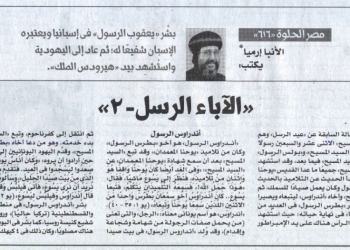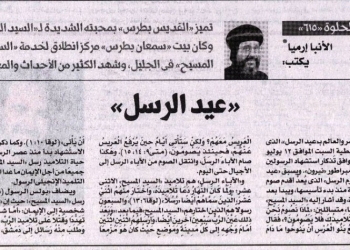In the previous article, we tackled the invincible firmness of Egypt’s people; we saw how all classes of people had never got weary, had never renounced their faith and had never been shaken by fear or death, setting an example of life with dignity. The connoisseur Tertullianus spoke about the martyrs of Egypt at that time saying, “If the whole world martyrs were put on a scale pan and the Egyptian martyrs on the other pan, the Egyptians’ pan would exceed in number”! Coptic martyrs were estimated to be nearly eight hundred thousand people.
Previously, we mentioned that Diocletian abdicated the throne to his assistant Gallerius in 305 AD, yet there is a story recounted about Diocletian and his raising.
The story says that Diocletian was raised in Akhmim city after his parents’ death, while he was still a child. A Christian man called Bisada raised him, and employed Diocletian as a shepherd. Bisada had a terrific dream that Diocletian would become an emperor for Rome, and that he would kill Bisada! Bisada told Diocletian about the dream, yet he didn’t believe that he, a humble shepherd, would become an emperor, and that he would kill the man who supported him and brought him up! After fifteen years, Diocletian joined the Roman army, and became a horse handler in the imperial barns, where the emperor’s oldest daughter saw him and loved him. After the death of the Emperor of Rome, his daughter assumed the power and got married to Diocletian, making him the Caesar of Rome. Amidst his persecutions against the Christians, he summoned his previous tutor, who became then a bishop of Ebsay Diocese, ordering him to burn incenses to the idols, the bishop refused, so Diocletian beheaded Bishop Bisada, turning the latter’s dream into a reality!
This story is found in some books and websites, yet looking it up in Arabic and foreigner references and in history books bore no results. It is stated rather, as we mentioned earlier, that he was born in the city of Salona, Dalmatia state, in the province of Illyria. References do not agree on his job as a horse handler, despite their agreement to his joining to the Roman military, and rising through the ranks of the military to become Roman cavalry commander. Diocletian continued his life in his own property at Salona until his death. Some references point out that Diocletian was struck with a mental disorder; he abdicated the throne due to his illness as he was unable to eat or to have a rest, instead, he kept on weeping and crying all the time. Afterwards, he lost his eyesight, his statues were smashed, and his pictures were removed until he died in 316 AD (according to some church references).
As for Maximianus, the rule partner of Diocletian was coerced by Diocletian, as stated in some references, to abdicate the throne as well, leaving the power to his assistant Constantinus. And thus, he assumed the power of Rome from 285 to 305. However, in 307 AD, he demanded to restore the throne as a support for his son, but Diocletian convinced him again to abdicate the throne in 308 AD, he lived in the royal court of King Constantine, who succeeded his father Constantinus. Maximianus committed suicide by hanging himself in 310 AD.
While Gallerius, Diocletian’s assistant in the East, continued harsh persecutions against the Christians, his rule was unjust merciless compassionless period to the flock, he counted the people and their properties, imposing high taxes on everyone, even the newborns! One of the historians mentioned that “If one of the tax payers died, or an animal upon which taxes were imposed died, the ruler would distribute their taxes incurred on the living ones!… No man or animal had escaped his oppression and arbitrary.”
He was struck by an abominated dangerous disease at late 310 AD; his entire body was full of sores, emitting an abominated smell that kept everybody far from him, which coerced him to issue a tolerance decree towards the Christians in 311 AD, in which he asked them to plead to their God for his sake! He died in 311 AD. As for his partner of the West, Constantinus; he was a just ruler, loving his flock and acting compassionately towards them, until his death in 306 AD. His son, Constantine, succeeded him on the throne.
The Copts have set the beginning of Diocletian’s rule to mark the offset of their Coptic Calendar known as “the Calendar of Martyrs”, which is used by the Coptic Orthodox Church in Egypt. During the Ptolemaic Era, Ptolemy III had made changes to the Egyptian calendar in 238 B.C. in which he increased the days of the Egyptian year, yet the Egyptian priests rejected such changes. In 25 AD, the calendar was reused again by Emperor August Caesar, who changed the Egyptian calendar to be in accordance with the Julian calendar, which is the basis of the Gregorian calendar followed in the West.
When the Egyptian Church desired to form a calendar – beginning from Diocletian’s rule – it did not abandon, but rather kept, its original Egyptian roots extending thousands of years ago; so it named the Coptic months after the months of the Ancient Egyptian calendar.
The Ancient Egyptian months were formed in Hieroglyphic language originally, then transformed into the Coptic language which represents the last phase of developing the Ancient Egyptian language. They are…
Tut (September 11 – October 10): named after the Egyptian god Tut/ Thoth; the god of wisdom, science and writing.
Baba (October 11 – November 10): derived from Opet, the original name of Luxor, the month’s name goes back to an ancient feast in which the Egyptians celebrated god Amun’s transfer from his temple in Al Karnak to his temple in Luxor.
Hatur (November 11 – December 9): named after Hathor, the Egyptian goddess of beauty, motherhood, giving, love and music.
Kiyak (December 10 – January 8): derived from the idiom (Ka– her- ka) which means ….., it refers to the Pharaonic feast of the spirits’ gathering.
Tuba (January 9 – February 7): derived from the ancient Egyptian word “Ta’ebt” which was one of the feasts.
Amshir (February 8 – March 9): refers to a feast linked to the Pharaonic god of tempests (Amshir).
Baramhat (March 10 – April 8): It is thought to go back to a feast related to King Amenhotep.
Baramuda (April 9 – May 8): named after the Pharaonic god of harvest “Renenutet”.
Bashans (May 9 – June 7): named after Khonsu, the Pharaonic god of the moon.
Ba’unah (June 8 – July 7): goes back to the ancient Egyptian celebration of the feast of the valley, in which Amun was transferred from the east of the Nile to its west.
Abib (July 8 – August 6): goes back to the feast of the Pharaonic god Abib.
Misra (August 7 – September 5): derived from the phrase (Meso Ra’) which means (the birth of Ra’).
Nasi’ (September 6 – September 10): It is also called the small month, in its first days; the ancient Egyptians celebrated the god of the other world Osir (Osiris in Greek).
The ancient Egyptians had formed the Egyptian calendar, which is considered among the first calendars known by humankind. It is the most accurate one regarding the climate and agriculture affairs in Egypt, as the Egyptian farmer has depended on it for thousands of years in identifying the proper seasons for cultivating different crops across the year. The Egyptian calendar is a Sun dependent one which divides the year into 13 months according to the Sun’s rotation.
These months were linked to popular sayings, which are still found in the minds of people – especially the farmers – as they bear climate related meanings. For example:
In the month of Tut, it is said: “Tut, water the lands and don’t miss it” I.e. a farmer shall irrigate his lands in this month, in order to take advantage of its cultivation.
In the month of Baba, it is said: “Go in and close the gate” to avoid the cold weather of that month.
In the month of Hatur, it is said: “Hatur is the month of sparkling gold”. Gold here refers to wheat.
In the month of Kiyak, it is said: “Kiyak’s mornings and evenings. End up with your lunch to be ready to have your dinner” It is a reference to the short days and long nights of that month.
In the month of Tuba, it is said: “Tuba turns the young girl to a decrepit woman” as a reference to the cold weather of that month which makes young girls bent like old women.
In the month of Amshir, it is said: “Amshir, the month of excessive storms, it blows the old women up”, reminding people of the strong winds of that month. Normally, a hot tempered person is described as “the storms of Amshir”.
In the month of Baramhat, it is said: “In Baramhat, go to the field and fetch something” referring to the fields being full of winter crops.
In the month of Baramuda, it is said: “In Baramuda, pound the shaft” I.e. grind the wheat seeds after ripening.
In the month of Ba’unah, it is said: “In Ba’unah, supplies are transmitted and stored” The supplies of the year are stored at this month.
In the month of Abib, it is said: “In Abib, the Nile water increases” as a reference to the flood.
Stories about Beautiful Egypt, which lives in her sons’ hearts, never end!
The General Bishop
Head of Coptic Orthodox Cultural Center


 العربية
العربية











